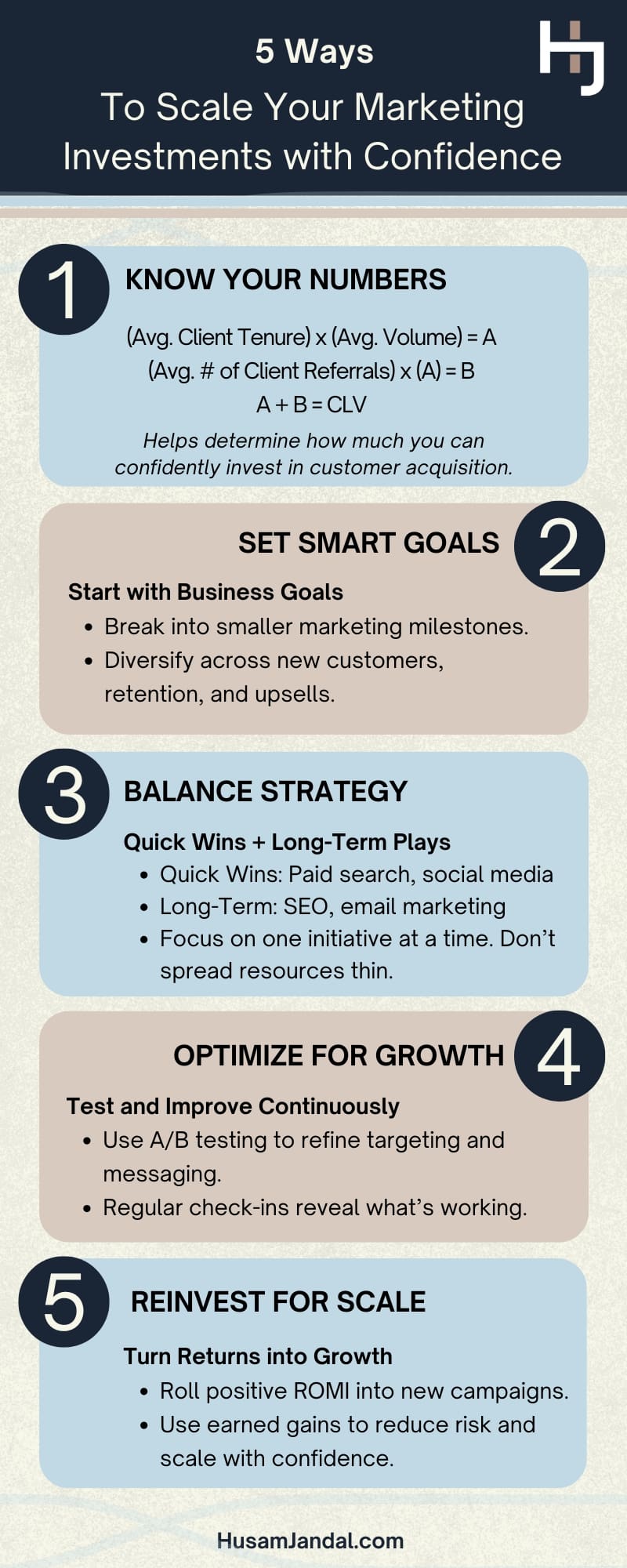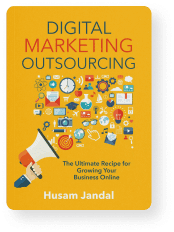 It’s often said that “It takes money to make money.” While most business owners intuitively know that making smart investments is vital to the health of their company and budget for improvements in products or services, sales, and infrastructure, marketing is often the last area to be funded and the first area to see cuts. However, it’s essential to scale marketing investments alongside your other initiatives. Not only will this allow you to generate revenue that can be reinvested in your marketing, effectively allowing it to pay for itself, but it’s also the only way most businesses can grow and break free from plateaus.
It’s often said that “It takes money to make money.” While most business owners intuitively know that making smart investments is vital to the health of their company and budget for improvements in products or services, sales, and infrastructure, marketing is often the last area to be funded and the first area to see cuts. However, it’s essential to scale marketing investments alongside your other initiatives. Not only will this allow you to generate revenue that can be reinvested in your marketing, effectively allowing it to pay for itself, but it’s also the only way most businesses can grow and break free from plateaus.
But even knowing all this, many business leaders are apprehensive about increasing their marketing investments. I’ll tell you a secret most marketing professionals won’t: you’re right to be apprehensive. A little apprehension is healthy. If you’re feeling it, it likely means nobody has made a business case for the outlay. Give me a few minutes, and I’ll walk you through how to move forward with clarity and confidence.
Know Your Customer Lifetime Value

One of the most important metrics to know as you scale marketing investments is your customer lifetime value (CLV), also referred to as LTV. This metric tells you how much value a customer brings your organization over the lifetime of the relationship.
When you know your CLV, it becomes much easier to determine how much money you can invest in the customer acquisition process. For instance, maybe you’ve set your maximum Paid Search bid at $50, but you’re not getting strong leads from that investment. Many business owners will pull back at this point, assuming Paid Search doesn’t work for them. However, it often means you’re not bidding competitively enough to reach high-quality leads.
How to Calculate CLV
If you’re unfamiliar with CLV calculations, you’re not alone. Just 42 percent of companies can accurately measure it, according to Zippia. While there are many methods to calculate CLV, I like to use a simplified version that also includes the referrals your happy client will bring. To calculate it, you’ll need to know:
- Tenure: Average customer tenure in cycles in months or years.
- Volume: Average customer purchase volume per cycle.
- Referrals: Average number of new referred customers from each existing customer.
CLV Formula
(Tenure) x (Volume) = A
(Referrals) x (A) = B
A + B = CLV
How to Use CLV to Determine Your Investment
Let’s say that you know a typical customer brings in $50,000 over the lifetime of the relationship, and you also know that around half of this goes directly to servicing the customer, and you need to keep around 20 percent as profit. That means your maximum ceiling for acquisition is 30 percent of this, which works out to $15,000. Every business will have different figures and margins, but doing this work upfront helps put your marketing investments in perspective. When you understand what you have to gain, it makes more sense to expand your budgets and bids.
Have Clear Goals and Measure Your Results
Many businesses start by framing out their marketing goals. For instance, maybe you want 100 leads this month. However, you actually need to start further up the chain with the company’s overall goals, then break that down into individual marketing goals.
How to Set Effective Goals
To illustrate the point, let’s say you’re setting business and marketing goals, and your overall business goal is to grow revenue by 20 percent this year. This boost doesn’t have to come exclusively from new customers. In fact, it’s smarter to diversify. For instance, maybe you will set a goal for new customer growth each month, but you might also work on customer retention, and also increase CLV by offering complementary products and services.
Break these goals into smaller milestones or monthly goals, and then break out which initiatives you’ll use to achieve them.
How to Measure Your Success
There are lots of metrics to measure marketing success. The right approach will vary based on your goals. For instance, calculating your return on marketing investment (ROMI), works for most initiatives, from paid advertising to email marketing. However, it’s not an effective measurement when you’re working on social media engagement campaigns or brand awareness.
Be sure you’re using the right measuring stick for the objective and medium. From there, schedule regular progress check-ins, such as weekly or monthly reviews. This will help you see when things are working and when to pivot, so you can feel more confident that your marketing dollars are being spent well.
Balance Quick Wins with Long-Term Strategy
With so many potential avenues to follow, it can be difficult to know where to begin. I like to use the analogy of the Digital Marketing Tree. With this approach, you lay a foundation, then start by picking up the “ground fruit.” These are essential elements of your digital marketing strategy that all other elements flow through, such as your website, and those that require minimal investment, like social media.
Layer in Quick Wins
With the basics in place, you can start leveraging strategies that pay off quickly, such as Paid Search. These can help you start generating revenue right away and help provide proof you’re on the right track. The data you gain from these campaigns can also be used to improve your other initiatives.
Build Toward Longer Strategies
Other strategies, such as search engine optimization (SEO), can take months before you start seeing results. However, it’s one of the most cost-effective methods of digital marketing. Plus, it allows you to diversify your leads, and the results tend to snowball over time, helping you future-proof your results.
Be Laser-Focused
One of the benefits of leveraging the Digital Marketing Tree method is that you work through the initiatives one at a time rather than starting everything all at once. This allows you to ensure each area is strong before you move on to the next and helps ensure you’re not spreading your resources thin.
Carry this focus through as you work through the various channels as well. For instance, when you incorporate social media, you don’t need to be on every platform. Instead, zero in on just the platforms that your audience is most likely to use.
Continue to Optimize
Have realistic expectations about your marketing timeline. Even the best-planned campaigns need time to gather meaningful data and start producing results. Ongoing optimization is where you’ll transform a good investment into a great one.
Use A/B Testing to Sharpen Your Approach
Think of every campaign as an opportunity to learn. A/B testing, or running two versions of an ad, email, or landing page with a single variable changed, helps you see what truly resonates with your audience. Over time, even small improvements in conversion rates can significantly increase your ROMI.
Refine Targeting and Messaging
Review your campaign performance regularly, ideally in your weekly or monthly check-ins. Are you reaching the right people? Are there audience segments or keywords draining your budget without producing results? By pruning what isn’t working and reallocating your budget toward what is, you ensure your marketing efforts stay efficient and effective.
Iterate for Compounding Growth
Optimization is an ongoing process. Each adjustment gives you better data for the next, creating a compounding effect that steadily improves your results. Whether you’re fine-tuning bids, updating ad creative, or tweaking your email subject lines, every iteration brings you closer to your goals and gives you greater confidence in your marketing investments.
Roll ROMI into Your Next Initiative
When your campaigns generate positive returns, you’re proving that your marketing works and creating a new funding source for future growth. Use the revenue earned from successful initiatives to finance your next steps, turning each win into fuel for bigger opportunities.
Reinvest for Momentum
Take the profits from high-performing campaigns and allocate them toward scaling proven strategies or testing new ones. For example, if your paid search campaign generated more revenue than it cost, dedicate those gains to increasing your budget on winning keywords or expanding into complementary channels.
Reduce Risk with Earned Gains
Reinvesting revenue from previous successes helps minimize the risk of additional marketing investments. Instead of pulling more from your core budget, you can fund future campaigns with money your marketing has already earned, creating a self-sustaining cycle that builds confidence in your ability to grow.
Keep Your Strategy Evolving
Using your ROMI to guide reinvestment decisions means each campaign builds on the last. This creates a continuous loop of learning and funding that compounds over time, helping your marketing become more efficient and impactful with every cycle.
Get Help Scaling Your Marketing Investments Effectively
As a digital marketing consultant with a background in business, I leverage proven strategies to ensure the companies I serve get maximum ROMI. If you’d like to discuss what that looks like for your business, contact me for a complimentary consultation.
FAQs on Scaling Marketing Investments
How can I identify high-ROI marketing opportunities?
Look for campaigns with measurable results that exceed your investment, such as paid ads or email marketing with strong conversion rates. Tracking customer lifetime value helps you focus on high-ROI marketing efforts that drive sustainable revenue.
How does marketing scalability impact my business growth strategy?
Marketing scalability ensures your campaigns can grow alongside your business. By building strategies that can expand efficiently, you create a business growth strategy that supports long-term success without overwhelming your team or budget.
What should I prioritize when planning a business growth strategy?
Focus on aligning marketing and sales, setting achievable milestones, and maintaining flexibility to adapt. Incorporating scalable marketing initiatives helps you future-proof your business growth strategy and seize new opportunities with confidence.
How do I know when to scale my marketing budget?
Look for signs like consistent positive ROMI, hitting or exceeding lead goals, and a proven ability to handle increased demand. These indicators show your marketing is ready for a larger investment.
What’s the safest way to scale a marketing budget?
Increase spend gradually on campaigns with proven success. Reinvest profits from high-performing initiatives and monitor results closely so you can adjust quickly if performance dips.
How can I scale my marketing budget without wasting money?
Set clear metrics, start by expanding top-performing campaigns, and test new channels with small budgets. Prioritize strategies that offer measurable returns to ensure each dollar contributes to growth.





































































